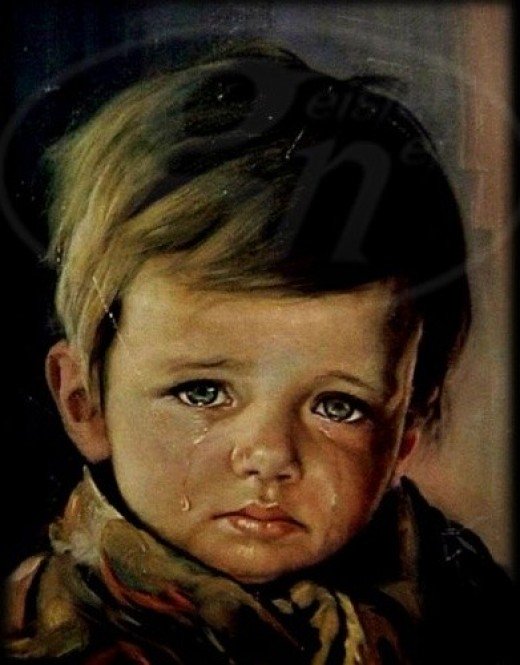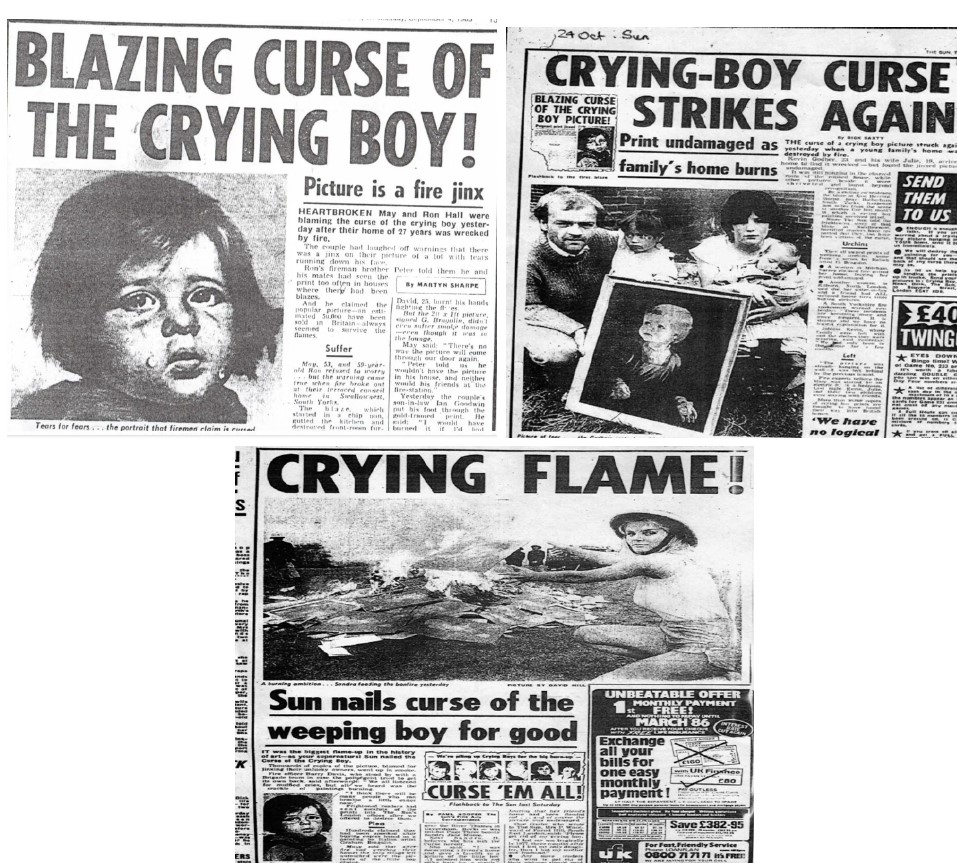
little Teardrop Tears
The Crying Boy Painting was painted by an Italian painter named Giovan Bragolin which is the pseudonym of a Spanish painter, Bruno Amodio also known as ‘Franchot Seville’ in the year 1950 and continued till 1970 and whoever used to put such paintings in their house, found their house to be burnt to ashes which made people believe that this painting is cursed.
- The Crying Boy Paintings were mass-produced and widely sold throughout the United Kingdom. On September 4, 1985, a British tabloid newspaper The Sun published an article about a couple, Ron and May Hall, whose house had burnt down due to a fire that had started in a chip pan and was blaming the curse of the crying boy. Everything burnt down except the painting; as a result, panic grew among people.
Who is the boy in the painting?

- Giovan also created many paintings like this and an urban legend circulates of him painting the children of a Spanish orphanage that were burned down after the Second World War.
- Another story tells that a school teacher by the name of George Mallory tracked down the artist and asked him about the boy in the painting to which Giovan said that the boy was a Spanish street urchin called Don Bonillo.
- Giovan had met him in Madrid in 1969 after fleeing from Italy after the end of World War 2 whose parents died in a mysterious fire set and so people started calling him by the name of “El Diablo” and so no one wanted to adopt him as wherever he would go, a fire would start.
- The boy was adopted by Giovan against the will of a priest and was abused by the painter, the paintings of the little sad orphan made him rich but one day his studio was mysteriously burnt down and he blamed him for the arson and the boy ran away and years after, the same boy was found dead in a car explosion in Barcelona.
- According to a journalist Dr. David Clark who researched about this mystery on his own website for Fortean Times, said that he could not find evidence that George Mallory who had tracked down the painter did even exist; he further implied that even Don Bonillo did not exist.
- Dr. David Clark further said that Giovan might have painted 20-30 of these crying boys after training in Venice after World War 2, prints of which were sold in departmental stores in the 1970s.
On September 4, 1985, The Sun published an article titled “Blazing Curse of the Crying Boy Picture!” which describes the story of Rona and May Hall, the next day The Sun ran a follow-up, saying they’d been flooded by calls from “horrified readers. ”
- Another reader by the name of Dora Mann said, her house burnt six months after she bought the painting and she also said that all the paintings were burnt except the painting of the crying boy.
- The Sun thrilled by the success of these stories, offered to take the “cursed” painting off people’s hands. Nearly 2500 prints of the Crying Boy were sent to their office and were soon stacked 12 feet high in the newsroom.
- A week after, they published another article titled “Crying-Boy Curse strikes Again” in which they talked about a young family’s home was destroyed by fire but only the painting remained intact.
- Their last article which covered this topic is titled “Crying Flame!” which was published on Halloween in which they claimed that they had burned down all the paintings in a huge bonfire which was organized near river Thames.
- They even quoted a fire officer, Barry Davis who was present at the event saying that, “I think there will be many people who can breathe a little easier now.”
The Sun’s involvement in the urban legend
Upon investigations it was found that most of these fires had normal causes, like cigarettes, faulty wiring, or unwieldy deep-frying pans.
- The Essex firefighters sifting through the ruins of destroyed homes found a disturbing pattern as everything was burnt except the Crying Boy painting, as a result, paranoia grew amongst the people.
- In 2010, a BBC radio presenter and writer, Steve Punt, investigated this curse in a BBC Radio 4 production called Punt PI. Hebegan to feel a bit nervous about the curse.
- So, he set the painting alight with a construction researcher named Martin Shipp and the side of the painting blackens but the painting itself does not burn.
- Upon testing at the Building Research Establishment (BRE), it was observed that beyond the string it hung from really did not burn while the lapel of the boy’s jacket was slightly burnt, and the painting suffered a hole and the damage stopped pretty quickly.
- This led them to believe that the prints were coated with fire-retardant varnish, which would easily account for why the paintings would remain unscathed in burned homes across the United Kingdom.
- Dr. David Clark also discovered that the painting was printed on a compressed board which would make it difficult to burn.
Was the painting really cursed?
Since a scientific explanation has been provided as to why these paintings do not catch fire, many people continue to believe that the painting is cursed and advise not to hang such paintings. Giovan Bragolin passed away in 1981 and the truth of this story has also gone with him and it is just a mere coincidence that all the houses burnt had these paintings adorning their walls and so people thought that the painting is cursed, this painting quickly became an urban legend and is still an amusing case to look at. So would you dare to hang this painting in your house?
Write and Win: Participate in Creative writing Contest & International Essay Contest and win fabulous prizes.
By Rohit Dalal, 15 Years Old, Hisar


